Centralized Traffic Control (CTC) is a method used to control train movements from a central location over a defined territory that may stretch for hundreds of miles. It has been in development for over 80 years. In 1927 General Railway Signal (GRS) developed the first installation of CTC on the New York Central between Stanley and Berwick, OH, a distance of approximately 45 miles.
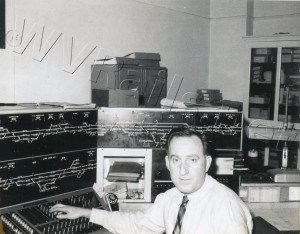 Huntington Dispatcher Red Vance at the controls. I took this Polaroid photo sometime in the mid 1960’s
Huntington Dispatcher Red Vance at the controls. I took this Polaroid photo sometime in the mid 1960’s
Prior to the invention of CTC and in subsequent years as it came into use by more railroads, CTC began to spell the end of control towers that dotted the nations rail lines. By the nature of its design, control tower operators could operate signals and switches for only several miles of mainline track.
Two views of the dispatcher’s control panel. Some of the names on the board were once names of control towers (cabins).
The Chesapeake and Ohio began a gradual installation of CTC on the Huntington Division between Handley and Huntington beginning in the 1950’s. At that time there were eight control towers (or cabins). They were Handley RO, Cabin Creek Jct CA, South Ruffner KO, St. Albans VF, Scott SC, Hurricane, KX, Milton MI , and Barboursville BR.
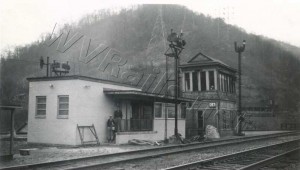 Current CA Cabin with newly constructed brick building that will be the new CA (Cabin Creek Jct.) Cabin. A.R. Hoffman photo courtesy Larry Fellure.
Current CA Cabin with newly constructed brick building that will be the new CA (Cabin Creek Jct.) Cabin. A.R. Hoffman photo courtesy Larry Fellure.
Prior to the above being consolidated to the dispatchers board at the Huntington passenger station building, tower consolidations began in 1953. A new brick office was built at CA Cabin Creek Jct. through the winter of 1952-1953. A CTC machine was installed in the new CA office covering the trackage from Cabin Creek Jct. to South Ruffner (Charleston). Thus the first use of CTC was in operation. South Ruffner was closed in the early months of 1953.
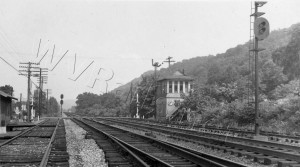 South Ruffner Cabin as it appeared in 1951.
South Ruffner Cabin as it appeared in 1951.
A.R. Hoffman photo courtesy Larry Fellure
At about the same time, or shortly afterward, the old St Albans Tower located near the passenger depot was replaced with a new brick building that was located in the middle of the wye of the Coal River Branch. A CTC machine was installed there and the territory was expanded to cover all mainline switches and signals in the wye and included Dock Siding.
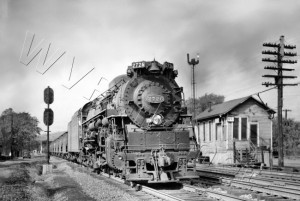 Kanawha Class Steam Locomotive 2726 heading eastbound past VF Cabin in St Albans some time around 1950. This cabin was closed when new VF Cabin was built. Please see my St. Albans post for picture. A.R. Hoffman photo courtesy Larry Fellure.
Kanawha Class Steam Locomotive 2726 heading eastbound past VF Cabin in St Albans some time around 1950. This cabin was closed when new VF Cabin was built. Please see my St. Albans post for picture. A.R. Hoffman photo courtesy Larry Fellure.
The installation of CTC continued westward in the mid 1950’s. Although the exact dates are not available, towers at Scott, Hurricane, and Milton were closed. The territories the cabins controlled were added to the CTC machine at St. Albans. Barboursville remained in operation most likely for a brief time period.
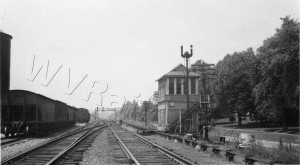 Hurricane Cabin as it appeared in 1951. A.R. Hoffman photo courtesy Larry Fellure
Hurricane Cabin as it appeared in 1951. A.R. Hoffman photo courtesy Larry Fellure
When CTC was installed in the dispatcher’s office at Huntington around 1960 or 1961, the territories that Cabin Creek Jct. and St. Albans controlled were combined. A new strip on the CTC board was added that covered Spring Hill and South Charleston. CTC was then advanced westward to DK Cabin whose eastern limits were at the Guyandotte River Bridge. This last link in CTC eliminated Barboursville Cabin. The CTC operation between Huntington and Handley at that time encompassed 70 miles of mainline track under control of one person.
The only cabin that was not consolidated was Handley. This could possibly be because it was the division point between the Huntington and Hinton divisions. In addition DK Cabin on the east end of Huntington Yard and HO on the west end remained in operation as well as Kenova KV. In Kentucky Big Sandy BS, Clyffeside SX and Russell RU remained in operation until the early 1980’s. Also sometime during this period DK and HO cabins were closed. Territories were combined in an office in the old passenger station and controlled by one operator.
This post was not intended to detail how CTC and control towers operated but to document changes of how train movements were controlled on the C&O over the period of years I lived in the Huntington-Charleston area. The change over to CTC between Handley and Huntington was completed about the time I was entering 7th grade.
My utmost thanks goes to fellow Collis P. Huntington Chapter member and retired CSXT (former C&O) employee Larry Fellure and his friend and former C&O operator Art Hoffman. They both furnished detailed information and dates used in this post and Art supplied the great pictures of the old cabins. If it wasn’t for them this post would not have been possible.


Very nice write-up Doug.
Not sure if this helps the cause or not, but according to various CSX employee timetable issues that I have, DK CABIN, HO CABIN and KV CABIN were closed sometime between March 1 and October 25, 1987.
Thanks Ron for the info.
Me and my son enjoyed reading your blog entry.
Im currently a train dispatcher in the huntington office for CSX…..and this really suprised me….besides the technology changing, the screens look pretty much the same….thanks for the pics.
Thanks for your nice comments. If I get up that way I would love to see the dispatch center.
the photo of the “cabin” at south ruffner-do you know what crossing it was located at? (27th street?)
Dave,
I believe it was a little further east but I will do some checking around.
Doug